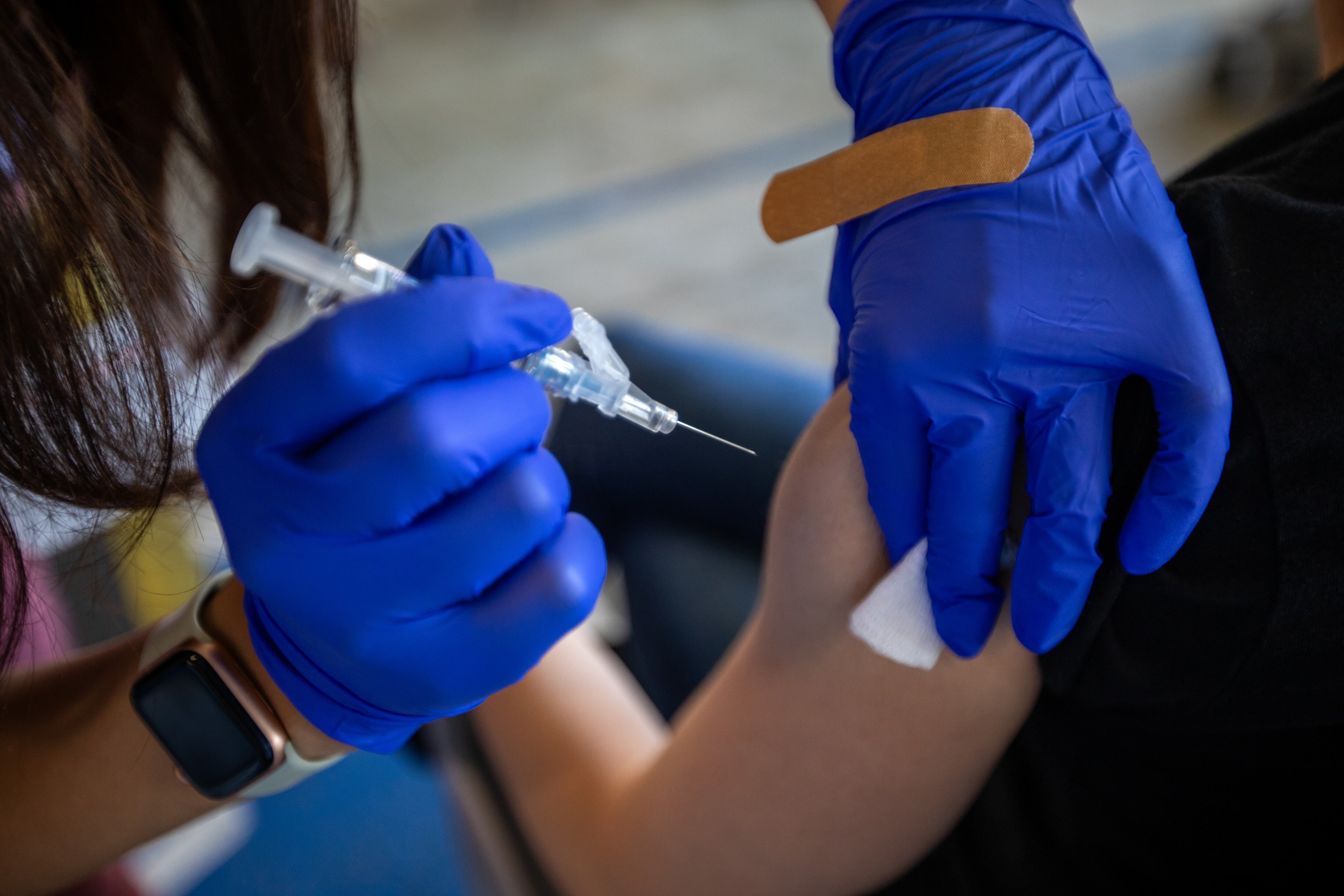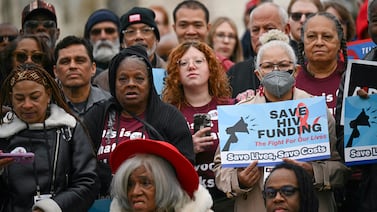Public health, explained: Sign up to receive Healthbeat’s free national newsletter here.
The FDA has approved an updated Covid shot for everyone 6 months old and up, which renews a now-annual quandary for Americans: Get the shot now, with the latest Covid outbreak sweeping the country, or hold it in reserve for the winter wave?
The new vaccine should provide some protection to everyone. But many healthy people who have already been vaccinated or have immunity because they’ve been exposed to Covid enough times may want to wait a few months.
Covid has become commonplace. For some, it’s a minor illness with few symptoms. Others are laid up with fever, cough, and fatigue for days or weeks. A much smaller group — mostly older or chronically ill people — suffer hospitalization or death.
It’s important for those in high-risk groups to get vaccinated, but vaccine protection wanes after a few months. Those who run to get the new vaccine may be more likely to fall ill this winter when the next wave hits, said William Schaffner, an infectious disease professor at Vanderbilt University School of Medicine and a spokesperson for the National Foundation for Infectious Diseases.
On the other hand, by late fall the major variants may have changed, rendering the vaccine less effective, Peter Marks, the FDA’s top vaccine official, said at a briefing Friday. He urged everyone eligible to get immunized, noting that the risk of long Covid is greater in the un- and undervaccinated.
Of course, if last year’s Covid vaccine rollout is any guide, few Americans will heed his advice, even though this summer’s surge has been unusually intense, with levels of the Covid virus in wastewater suggesting infections are as widespread as they were in the winter.
Covid hitting West and South hardest
The Centers for Disease Control and Prevention now looks to wastewater as fewer people are reporting test results to health authorities. The wastewater data shows the epidemic is worst in Western and Southern states. In New York, for example, levels are considered “high” — compared with “very high” in Georgia.
Hospitalizations and deaths due to Covid have trended up, too. But unlike infections, these rates are nowhere near those seen in winter surges, or in summers past. More than 2,000 people died of Covid in July — a high number but a small fraction of the at least 25,700 Covid deaths in July 2020.
Partial immunity built up through vaccines and prior infections deserves credit for this relief. A new study suggests that current variants may be less virulent — in the study, one of the recent variants did not kill mice exposed to it, unlike most earlier Covid variants.
Public health officials note that even with more cases this summer, people seem to be managing their sickness at home.
“We did see a little rise in the number of cases, but it didn’t have a significant impact in terms of hospitalizations and emergency room visits,” Manisha Juthani, public health commissioner of Connecticut, at said at a news briefing on Wednesday.
Unlike influenza or traditional cold viruses, Covid seems to thrive outside the cold months, when germy schoolkids, dry air, and indoor activities are thought to enable the spread of air- and saliva-borne viruses. No one is exactly sure why.
“Covid is still very transmissible, very new, and people congregate inside in air-conditioned rooms during the summer,” said John Moore, a virologist and professor at Cornell University’s Weill Cornell Medicine College.
Or “maybe Covid is more tolerant of humidity or other environmental conditions in the summer,” said Caitlin Rivers, an epidemiologist at Johns Hopkins University.
Covid vaccine uptake has waned
Because viruses evolve as they infect people, the CDC has recommended updated Covid vaccines each year. Last fall’s booster was designed to target the omicron variant circulating in 2023. This year, mRNA vaccines made by Moderna and Pfizer and the protein-based vaccine from Novavax — which has yet to be approved by the FDA — target a more recent omicron variant, JN.1.
The FDA determined that the mRNA vaccines strongly protected people from severe disease and death — and would do so even though earlier variants of JN.1 are now being overtaken by others.
Public interest in Covid vaccines has waned, with only 1 in 5 adults getting vaccinated since last September, compared with about 80% who got the first dose. New Yorkers have been slightly above the national vaccination rate, while in Georgia only about 17% got the latest shot.
Vaccine uptake is lower in states where the majority voted for Donald Trump in 2020 and among those who have less money and education, less health care access, or less time off from work. These groups are also more likely to be hospitalized or die of the disease, according to a 2023 study in The Lancet.
While the newly formulated vaccines are better targeted at the circulating Covid variants, uninsured and underinsured Americans may have to rush if they hope to get one for free. A CDC program that provided boosters to 1.5 million people over the last year ran out of money and is ending Aug. 31.
The agency drummed up $62 million in unspent funds to pay state and local health departments to provide the new shots to those not covered by insurance. But “that may not go very far” if the vaccine costs the agency around $86 a dose, as it did last year, said Kelly Moore, CEO of Immunize.org, which advocates for vaccination.
People who pay out-of-pocket at pharmacies face higher prices: CVS plans to sell the updated vaccine for $201.99, said Amy Thibault, a spokesperson for the company.
“Price can be a barrier, access can be a barrier” to vaccination, said David Scales, an assistant professor of medicine at Weill Cornell Medical College.
Without an access program that provides vaccines to uninsured adults, “we’ll see disparities in health outcomes and disproportionate outbreaks in the working poor, who can ill afford to take off work,” Kelly Moore said.
New York state has about $1 million to fill the gaps when the CDC’s program ends, said Danielle De Souza, a spokesperson for the New York State Department of Health. That will buy around 12,500 doses for uninsured and underinsured adults, she said. There are roughly 1 million uninsured people in the state.
What to do this fall
CDC and FDA experts last year decided to promote annual fall vaccination against Covid and influenza along with a one-time respiratory syncytial virus shot for some groups.
It would be impractical for the vaccine-makers to change the Covid vaccine’s recipe twice every year, and offering the three vaccines during one or two health care visits appears to be the best way to increase uptake of all of them, said Schaffner, who consults for the CDC’s policy-setting Advisory Committee on Immunization Practices.
At its next meeting, in October, the committee is likely to urge vulnerable people to get a second dose of the same Covid vaccine in the spring, for protection against the next summer wave, he said.
If you’re in a vulnerable population and waiting to get vaccinated until closer to the holiday season, Schaffner said, it makes sense to wear a mask and avoid big crowds, and to get a test if you think you have Covid. If positive, people in these groups should seek medical attention since the antiviral pill Paxlovid might ameliorate their symptoms and keep them out of the hospital.
As for conscientious others who feel they may be sick and don’t want to spread the Covid virus, the best advice is to get a single test and, if positive, try to isolate for a few days and then wear a mask for several days while avoiding crowded rooms. Repeat testing after a positive result is pointless, since viral particles in the nose may remain for days without signifying a risk of infecting others, Schaffner said.
The Health and Human Services Department is making four free Covid tests available to anyone who requests them starting in late September through covidtests.gov, Dawn O’Connell, assistant secretary for preparedness and response, said at Friday’s briefing.
The government is focusing its fall vaccine advocacy campaign, which it’s calling “Risk less, live more,” on older people and nursing home residents, said HHS spokesperson Jeff Nesbit.
Not everyone may really need a fall Covid booster, but “it’s not wrong to give people options,” John Moore said. “The 20-year-old athlete is less at risk than the 70-year-old overweight dude. It’s as simple as that.”
Arthur Allen is a reporter with KFF Health News, Healthbeat’s national reporting partner. Eliza Fawcett is a reporter covering public health in New York City for Healthbeat. Rebecca Grapevine is a reporter covering public health in Atlanta for Healthbeat. Amy Maxmen, Healthbeat’s national reporter through KFF, contributed to this report.







